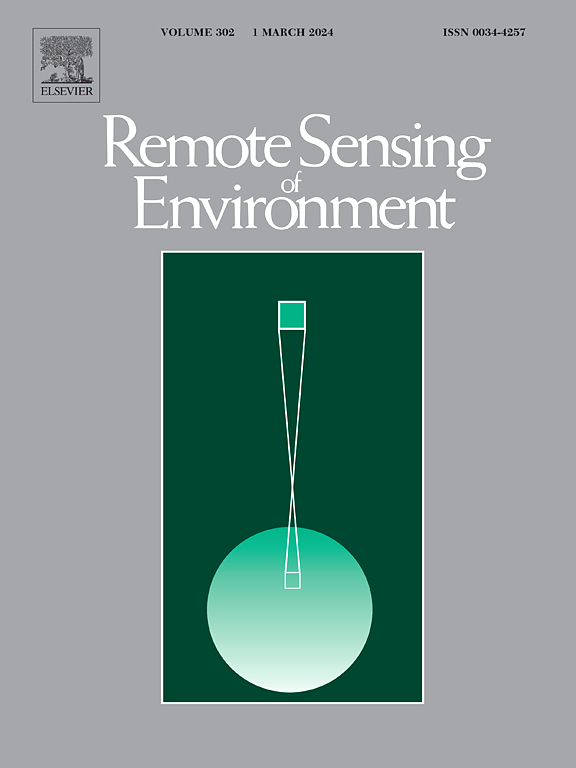叶木分离算法对地面激光扫描估算地上生物量的影响
IF 11.4
1区 地球科学
Q1 ENVIRONMENTAL SCIENCES
引用次数: 0
摘要
叶木分离在利用地面激光扫描(TLS)点云估算树木地上生物量(AGB)中起着重要作用。然而,叶-木分离的研究主要集中在报道叶-木点分离的准确性。基于常用的定量结构模型(qsm),对这些算法对后续AGB估计影响的评估是有限的。因此,在本研究中,我们使用独立的基准数据集量化了11种已发表的叶木分离算法对基于qsm的树木AGB估计的影响。基准数据集由哈佛森林混合温带森林中20棵破坏性采伐树木的AGB测量值和Wytham森林中856棵阔叶树在落叶条件下的人工分割树点云的QSMs估计的AGB组成。将这些基准AGB值与在同一棵树的叶子上的树点云上执行不同分离算法所产生的叶片上的点云上建立的QSMs估计的AGB进行比较。研究结果表明,对于大多数算法,与哈佛森林中破坏性测量的AGB相比,对针叶树和阔叶树的叶片去除AGB估计低估了AGB(针叶树:- 17%至- 3%,阔叶树:- 14%至- 2%)。在威瑟姆森林中,与落叶点云的AGB相比,所有分离算法中去除叶片的AGB估计始终低估了AGB(- 46%至- 24%)。大多数叶-木分离算法在阔叶树上比在针叶树上表现更好。此外,不同算法对同一森林类型树木的AGB估计存在显著差异。对于针叶树,QSMs和分离算法对去叶AGB估计的相对差值(RD)在−27% ~ 16%之间,其中表现最好的算法表现出相似的最优性能,RD值较小,约为−3% ~ 2%。对于阔叶树,QSMs和8种分离算法的去叶AGB估计值以及落叶点云估计值(约为10%)与采伐基准值非常接近,其中表现最好的算法的RD值约在±2%以内。此外,大多数分离算法对树干生物量的估计优于对树枝生物量的估计,而对树枝生物量的估计一直表现出不同程度的低估。这些发现为利用叶木分离算法进行基于qsm的AGB估计提供了及时的参考。本文章由计算机程序翻译,如有差异,请以英文原文为准。
The impact of leaf-wood separation algorithms on aboveground biomass estimation from terrestrial laser scanning
Leaf-wood separation plays an important role in estimating aboveground biomass (AGB) of trees from terrestrial laser scanning (TLS) point clouds. Yet, leaf-wood separation studies have predominantly focused on reporting the accuracy of leaf and wood point separation. Assessments of the impact of these algorithms on the subsequent AGB estimations, based on commonly used quantitative structure models (QSMs), have been limited. Therefore, in this study, we quantified the impact of 11 published leaf-wood separation algorithms on QSM-based tree AGB estimation using an independent benchmarking dataset. The benchmarking dataset consists of AGB measured for 20 destructively harvested trees from a mixed temperate forest in Harvard Forest and AGB estimated from QSMs built on manually segmented tree point clouds of 856 broadleaved trees in Wytham Woods under leaf-off conditions. These benchmarking AGB values were compared to the AGB estimated from QSMs built on the leaf-removed point clouds resulting from the different separation algorithms performed on the leaf-on tree point clouds of the same trees. The results of the study indicated that for most of the algorithms, the leaf-removed AGB estimates for both coniferous and broadleaved trees underestimated the AGB (conifers: −17 % to −3 %, broadleaf: −14 % to −2 %) compared to the destructively measured AGB in Harvard Forest. In Wytham Woods, leaf-removed AGB estimates from all separation algorithms consistently underestimated the AGB (−46 % to −24 %) compared to the AGB from the leaf-off point clouds. Most leaf-wood separation algorithms performed better on broadleaved trees than on coniferous trees. Moreover, significant differences were observed among different algorithms in estimating AGB for trees of the same forest type. For coniferous trees, the relative difference (RD) of leaf-removed AGB estimates from QSMs and separation algorithms ranged from −27 % to 16 %, among which the best performing algorithms demonstrated similar optimal performance, with small RD values of approximately −3 % to 2 %. For broadleaved trees, the leaf-removed AGB estimates from QSMs and eight separation algorithms, as well as leaf-off point cloud estimates (approximately at 10 %), were closely in agreement with the harvested benchmark values, among which the best performing algorithms had a RD value approximately within ±2 %. Additionally, most separation algorithms could lead to better estimates of trunk biomass than branch biomass, whereas the estimation for branch biomass consistently exhibited varying degrees of underestimation. These findings provide a timely reference for utilizing leaf-wood separation algorithms for QSM-based AGB estimation.
求助全文
通过发布文献求助,成功后即可免费获取论文全文。
去求助
来源期刊

Remote Sensing of Environment
环境科学-成像科学与照相技术
CiteScore
25.10
自引率
8.90%
发文量
455
审稿时长
53 days
期刊介绍:
Remote Sensing of Environment (RSE) serves the Earth observation community by disseminating results on the theory, science, applications, and technology that contribute to advancing the field of remote sensing. With a thoroughly interdisciplinary approach, RSE encompasses terrestrial, oceanic, and atmospheric sensing.
The journal emphasizes biophysical and quantitative approaches to remote sensing at local to global scales, covering a diverse range of applications and techniques.
RSE serves as a vital platform for the exchange of knowledge and advancements in the dynamic field of remote sensing.
 求助内容:
求助内容: 应助结果提醒方式:
应助结果提醒方式:


